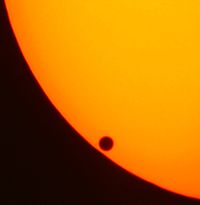A historic cosmic spectacle that will not be seen again for another 105 years will be shared with the public from York’s Keele campus tonight.
Staff at the York University Astronomical Observatory are hosting a free, public viewing of the transit of Venus, a rare celestial event that sees the planet Venus travel across the face of the sun.
“The next time this happens will be 2117, so anyone alive right now won’t get the chance to see another one,” says observatory director Paul Delaney. “It’s the solar system’s dynamics in action. You’ve got a chance to look at the sun, the sun spots and solar flare which is very active at the moment and you can see the closest planet to the Earth slide across the face of the sun.”
In the main observatory domes, attached to the northwest corner of the Petrie Science and Engineering Building and the Chemistry-Life Sciences Building courtyard, astronomers and stargazers will have the opportunity to watch through portable telescopes equipped with filters and transit “observing” glasses to prevent eye damage as Venus embarks on its seven-hour journey beginning at 6:04 p.m.
Due to construction near the observatory, it can only be accessed from the skywalk bridge on the third floor of York’s Petrie Science and Engineering building.
Viewing begins at 5:30 p.m. and bright light images of the sun have already been displayed on the York University observatory website.
Delaney says watching Venus’ entire crossing will not be possible for those in most areas of North and Central America because the sun will set at about 8:55 p.m. Observation of the transit will last from 6:04 p.m. until when the sun gets too low to observe, which he estimates will probably be around 8:30 p.m. behind the Life Sciences Building.
“We’re only going to see about two-and-a-half to two-and-three-quarters of that seven hours, but if you were in Hawaii or Australia for example, you would be able to watch Venus ingress and then eventually seven hours later, egress,” he says.
The last transit of Venus across the face of the Sun occurred in 2004. Delaney says this is the seventh time such an event has occurred since the invention of the telescope in 1610.
Five of those seven Venus transits were used to measure the first scales of the solar system’s size, such as estimates of the distance from the Sun to the Earth, says Delaney. He explains that because of our current use of satellites, the event is being used to help better understand exoplanets – planet that orbit a star other than Earth in a solar system.
“When we’re observing planets orbiting other stars, very often the way we’re detecting those planets is by looking at them pass across the disk of their stars and watching the way the light changes and diminishes,” he says.
“If we can better understand how that phenomenon is working here we can perhaps, for example, interpret the existence of atmospheres around those very distant exoplanets, so now we’re beginning to use observations in our own solar system to better understand planetary systems around other stars.”
A live broadcast of tonight’s transit of Venus event will also be available online at: http://connect.yorku.ca/OPV



